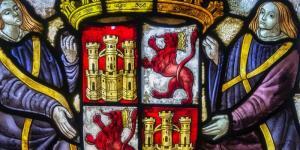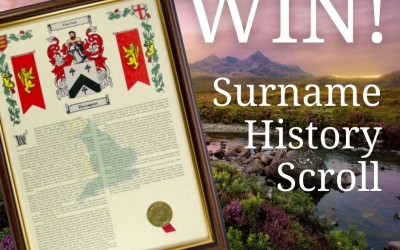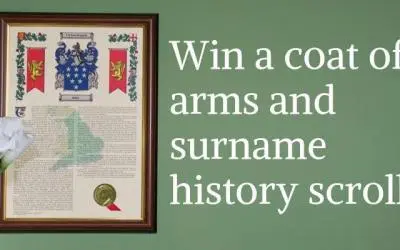Are you considering purchasing a print but want to know about the information on a coat of arms scroll? In this article you will find out a a bit more about the information that features on each print. You will make discoveries about the name that are will create intrigue! Plus, each coat of arms scroll is a fantastic way to add colour to your own family history research.
The coat of arms and heraldry
The coat of arms is featured in full colour at the top of your scroll, and the colours are true to heraldic standards. Learn more about colour in heraldry here. You will see that the coat of arms is rich in symbolism, with many coats of arms showing several symbols in a small space. This is because there is meaning attached to the imagery on each coat of arms scroll. Each image was specifically chosen to project a certain character trait in the bearer, or one of their achievements or successes. If you would like to look up the symbolism of the coat of arms, then check our free online heraldry dictionary.
We have loads of information about heraldry on our dedicated blog section. For example, find out all about the symbolism of autumn. Animals feature prominently, and each coat of arms scroll is likely to feature animal symbolism of some sort. Read all about animals in heraldry in our special series – parts one, two, and three explain all about some of the more commonly-found animal symbols.
The coat of arms at the top of your scroll creates an eye-catching piece of artwork to feature in your family home, and would the prints equally make great gifts. After all, everyone likes to find out a bit more about themselves! Plus, if there is a motto associated with coat of arms, it will be featured in a scroll below the artwork. Don’t worry if it is in a language that you don’t understand, because we will provide a translation! We often see mottoes in Gaelic, Welsh, and Latin to name a few.

Ancestors’ Coat of Arms
Does my coat of arms scroll show my personal heraldry?
The coat of arms scroll displays the earliest coat of arms relating to a bearer of the name. Often, this goes back many hundreds of years. You will therefore probably see other coats of arms when searching internet images, and these are most likely from later time periods.
Our dedicated team of researchers have been investigating coats of arms for more than 40 years. So, the coat of arms shown at the top of your print is a replica of that heraldry. It is not specific to you as an individual, but rather an item of artwork with historical reference to your own surname. To find out more, check out our blog ‘Does my family name have a coat of arms’. It is packed with useful information and links on how to go about petitioning for your own coat of arms.
If you are keen to find out more about how we research your surname, then we also have a blog article which will explain it in more detail.
What about the wording on the coat of arms scroll?
Each coat of arms scroll has around 1500 words of information about your chosen surname. This starts with information about where the name is derived from. For example, it could of geographical origin, occupational, descriptive or patronymic – handed down from father to child. (For example, ‘Johnson’). Learn more about the types of surname and their hidden meanings.
You will then read information about the types of documents that have been consulted to compile the research. Then you will discover the spelling variations relating to the surname. Names were often spelled in a variety of different ways. They were literally spelled how they sounded, so that one person’s version could vary from another’s.

discover your surname meaning
Next on your coat of arms scroll, you will read about where the family name first emerged. This includes information about any lands held. The coat of arms scroll goes on to feature information about migration to the new world, including America, Australia and more. We have many articles in our blog section about migration to the new world. Click here to find a variety of articles which you might find useful.
Often, there are notable bearers of the name which warrant scrutiny. For example, your coat of arms scroll will show if there were any passengers bearing your surname name on board the Titanic. You might also find out about convicts transported to the penal colonies!
The artwork on your coat of arms scroll
Surrounding the coat of arms at the top of your print, you will see highly decorative artwork, to add the finishing touch to your scroll. This artwork specifically relates to the country of origin of your chosen name. Our English name histories feature a lion, and the Scottish ones a thistle emblem. The Irish name scrolls show a Celtic cross and the Welsh prints show a dragon. Each print also has a watermark relating to the country of origin.

Language of Heraldry
Choosing the name origin
Sometimes, a name is shown as having several options relating to its origin, and the surname history will focus on that area. Simply enter your name in our search facility and it will show you all possible choices.
Finishing touches
Each print is completed with a special gold ‘seal’ with red ribbon. This is applied by hand once we have prepared your information. On the reverse, you will be able to read a full bibliography of sources, which could be a starting point for your own name research.
Finding out more
We have a wide selection of useful articles on our blog, including the history of Cornish surnames, and a guide to Scottish surnames. If you would like to discover more about your own surname, then you can order your own coat of arms and surname history print now.
Have you found out anything interesting about your surname and its early origins? We’d love you to share your story! Please tell us what you have learned!
Learn more about how we create your coat of arms scroll here.



